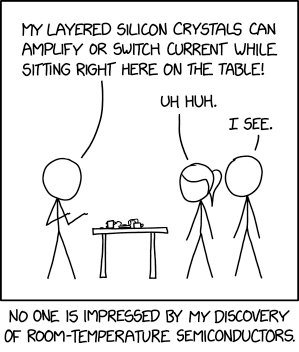- cross-posted to:
- hackernews@lemmy.smeargle.fans
- hackernews@derp.foo
- cross-posted to:
- hackernews@lemmy.smeargle.fans
- hackernews@derp.foo
As always, this is why peer-review is taken in such high regard. Replicate, replicate, replicate.
Well, just to push back a little on any impression some might get from this episode of the health of science (all IMO of course)
Most things aren’t subjected to replication attempts like this, largely because I think people have a decent amount of self-interest in getting on top of this material as early as possible if the claims are real, and, the manufacturing of the material is relatively trivial. In science in general, game changing technologies or techniques can get replication attention like this, but overall a lot of “discoveries or findings” just aren’t challenged as there is no real incentive to do so as a researcher, to the point that often you’ll get pushback if you try to publish a failed replication study.
And, lots of replications of an experiment mean teams are more likely to run into different problems at different times and solve them in parallel. It shakes the bugs out faster.
our compound shows greatly consistent x-ray diffraction spectrum with the previously reported structure data
Uhh, doesn’t look like it to me. This paper’s X-ray diffraction spectrum looks pretty noisy compared to the one from the original paper, with some clear additional/different peaks in certain regions. That could potentially affect the result. I was under the impression from the original paper that a subtle compression of the lattice structure was pretty important to formation of quantum wells for superconductivity, so if the X-ray diff isn’t spot on I’ll wait for some more failures before calling it busted.
yea interesting! It’s definitely the arc I’m hoping for here …
that either the material is tougher to make than the papers suggest, or,
to get into my fantasy land, the material they made is a superconductor but they don’t really know why or how to make it the way they did as it was kinda some accident they weren’t in control of. If true, it would make whatever is left of the material rather valuable and subject to some drama I’d imagine.
That tracks. Superconductor physics isn’t my field (shock, gasp) but I do recall reading Chu’s 1-2-3 paper way back when, in which the purpose of physical compression during synthesis of the samples was laid out in some detail.
Wait, did people actually believe this was real? I’d seen it faked before, so was a bit jaded at the news.
Glad to have peer reviews!
One fraud happened and therefore everything with the word “conductor” in it is fraud afterward? The Jan Schon scandal was about single-molecule semiconductors, which have nothing to do with lead apatite superconductors.
Scientific fraud is a weird phenomenon that many do not intuitively see coming. That it happens at all is worth keeping in mind, as well as the manner in which it is done. When a new finding seems to good to be true, it helps to remember that it may just be so.
In this particular case, my feeling is that an unhealthy lab dynamic led to a small group of people get carried away with their excitement. I’m betting fraud hasn’t happened here, but rather scientific negligence in the pursuit of glory. All my relatively uninformed speculation of course …
From what I’ve gathered the group of 3 comprise one elder and former supervisor and two former graduate students. Don’t underestimate the weird sway a scientific elder can have on younger researchers, nor the strange psychology that can develop around the pursuit of one’s legacy. Competing with Einstein and Nobel prize winners can be a helluva drug, and the elder/senior research can influence all sorts of decisions and aspects of the research through the amount of deference the receive from the younger researchers.
As for the two younger researchers, without knowing where their careers are up to, they’re probably fairly desperate to get more papers and grants, as all researchers are. Once you’ve started a project, you want something out of the time you’ve spent on it. If you’ve dived in on a long shot project that might go no where, you start to really want to find something in there the longer it goes all while sunk-cost fallacies haunt you everyday and pull you along longer and deeper than you really wanted to go. Combined with respect and deference to an elder pushing them along, the young researchers may very well have found themselves in a weirdly confusing space with not entirely healthy mindsets. I’m talking about losing perspective on what matters in terms of research/scientific integrity as well as managing resources for the sake of their life and career and how much trust they have for their research group on the whole, where a good deal of weird suppression followed by dramatic outbursts in an unhealthy mental health sense can happen.
Now that is all speculation, of course, but I write it just to illustrate that these kind of situations can occur, especially in science/research, and it’s helpful to be aware when dramatic confusing things like this situation arise.
That’s fair, I could’ve easily been wrong!
deleted by creator
The guy behind this paper has the exact same issues as Schon. Plagiarism in his PhD thesis, faked data, retracted papers, etc.
No he doesn’t?
Don’t get me wrong there are many places where the paper can be wrong (eg fig 1 or their magnetism exceptionally looking more similar to diamagnetism than superconductivity) but you are mixing him up with Ranga Dias who has had a history of data fabrication.
Dias has nothing to do with this paper though.Got a source? When I first read about this people were cautiously optimistic partly because the head researcher was well-respected.
Btw. Schön Didn’t plagiarize in his PhD thesis, the title was removed because of his other shortcomings
I did not know this story! Thanks! Important precedent it seems in framing a foundation of scepticism.
Unfortunately it’s a 3 part (~2.5 hour) series, but I thought it was worth the time. Definitely made me wary on the topic LOL
I was, and am, skeptical, but I also must admit, the potential breakthrough is teasing my psyche with that feeling of just wanting it to be real. A part of me hopes that maybe it will still end up confirmed by other peers, but, granted, it was a low chance even when the news first came out.
I agree, I was a bit cynical when I made that comment but the other commenter made me lessen my stance. It’s definitely got that BATTERY BREAKTHROUGH vibe tho 😆
From what I have heard, it’s not supposed to be that expensive or even difficult to make. They should have sent actual samples of the material to a dozen different universities from a batch they share their own data measurements about. Save everyone a lot of time about doubts that it’s manufactured correctly.
From that article:
“The general public seems oddly pumped about how ‘easy’ the 4-day, multistep, small batch, solid state synthesis is,”
The process is a 3-stage heating-holding-cooling process which they haven’t published the precise temperature profile for. The papers also claim only 4 samples were ever made in total, 2 of them got (destructively) analyzed by gas spectroscopy and crystallography, while of the other 2, one got further temperature annealed, and both got electrically characterized.
Chances are, they themselves don’t know exactly how they got what they got, and may or may not be capable of producing more samples.
I imagine they only have a few grams of the stuff. And they’re not highly motivated to be debunked immediately
but if it were real, they were claiming it could be manufactured easily, so making some samples to send out to research labs would not be too difficult
Right. And they haven’t. Now what may we deduce about their confidence in these results?
For anyone interested, there is a forum thread which is the closest thing we have to a live blog, along with the thread author’s opinions on how veritable the claims of each party currently known to try and replicate the study are.
Would a mega thread here help?
Though, lemmy.world is still defederated right? sh.itjust.works too? Maybe it’d be nicer to have one they could access too?
Meh, I think the people that are interested in the spacebattles thread will have found it through other means like HN. As for discussing the events as they unfold I think that’s best left to the forum itself, rather than discuss it at a proxy on Lemmy
I think it will be a while before we know what’s really happened.
Something I find striking is the question of where their original material is and where’s the video evidence of them testing it?
If I allow myself to be somewhat conspiratorial, I’d imagine that they know the material they made may have been somewhat accidental and that any further progress may depend on analyzing the material itself to determine what makes it work, which means they may want to keep its location somewhat secret.
Otherwise, I’m inclined to think that there’s something funky going on within the dynamics of the research group and that not one of them is entirely on top of everything that happened with the material and so the evidence got mixed up and foggy.
It is notoriously hard to replicate things in labs, especially with material science.
This was attempt to do it within 2 days of the paper being published.
To add to that, the original researchers apparently had 10% successes rate in their lab, they wanted to perfect it before publishing their paper.
Bad luck was that it leaked, so to make sure somebody else doesn’t get credit for their work they published what they had within hours.
It likely will take months before this will be verified.
10% success rate suggests there’s some hidden factor they haven’t discovered themselves yet, might influence the success rates of other labs. (assuming of course the claim is not fabricated)
That’s often how it goes. Something doesn’t do what you expect, so you have to keep trying new things until you figure out why it wasn’t what you expect.
It’s a shame that it so far seems that this superconductor experiment was a bust, but even still, I’m happy to see the scientific process at work.
What, one failed experiment about 15 minutes after the paper was first published is sufficient grounds for declaring the technology a bust is it?
No but a previous history of making shit up and falsifying data along with a failure to replicate?
They don’t have a history of making stuff up. Just because one group did doesn’t automatically mean everyone else is. The probability that something is made up doesn’t change just because somebody previously did or did not make something up.
Jeez you seem like you have some personal vendetta against this lab
For the last twenty-some years, yeah. Unfortunately. People love to hate on stuff.
Nope, but I’m leaning toward the side of caution. If the super-conductor is real it will be shown as such within a few weeks and will be revolutionary, and if not I’ll be less disappointed if I’ve steeled myself to the possibility.
Ok, what is the importance of a room temperature semiconductor.
Room temperature superconductor. Not semiconductor, that’s something different.
With it we can build all sorts of otherwise impossible technologies.
Batterys with massive charge capacities that last weeks.
Stupidly high speed hover trains.
Electrical wires that don’t heat up with use, don’t waste energy, and can never electric you.
Body armour that actually repels bullets.Probably some kind of horrific bomb.
Probably some kind of horrific bomb.
It looks like the big technological leap in relation to ‘How can we use superconductors to hurt things’ is to use them in making advanced EMP devices. It doesn’t seem like anyone has figured out any other obvious use cases for them that massively change or improve upon the other horrific devices that we’ve already come up with.
In regards to potential for use in war crimes, it could be a lot worse.
One thing I could think of would be miniaturized railguns. A large part of the bulk in rail guns at the moment is the cooling system for the electro magnets and capacitors to deal with inefficient power delivery.
A room temperature superconductor would fit both problems.
That would make some orbital insertions a lot cheaper, too.
Railguns have the unfortunate side effect of applying their full acceleration over just the length of their rails, which tend to be relatively short compared to the thickness of the atmosphere.
They’re fun to shoot some bullets at hypersonic speeds, not so much to impart higher than orbital speeds to complex structures when they get pancaked before leaving the muzzle.
Room temp superconducting magnets should make motors and power generation a bit more efficient. Magnetic plasma confinement gets a shit load easier as well.
Those are currently viable with conventional technologies. Explosively pumped magnetic coils with some big-ass capacitors. You could probably do something similar with a spark gap instead of a coil.
Room temperature superconductors would make them easier to build. Probably smaller.
These are some of the dumbest proposed applications I’ve ever seen for this. You have no idea what you’re talking about.
That’s not a nice thing to say. I bet they —and everyone— could learn from getting some of the myths dispelled, instead of just getting insulted.
I don’t have time to write all of that out. Start over without any of these guesses as to what these materials do. It’s irresponsible to say things as if they’re facts, when you know nothing of the subject. Like your most recent post.
You wrote a decent response a few comments down, that’s good enough. This isn’t ExpertSexChange, so some people might not be experts, but I think we can collectively manage the basic stuff while treating everyone with respect. As for my most recent post, I’ll admit having sent it before fully reading their sources, but probably should discuss it over there if you want?
While I appreciate that you’re trying to point out factual errors in the comment you are replying to, please keep in mind Beehaw’s primary principle (and only* rule) when interacting with folks in the comments: Be(e) Nice. You can correct factual errors, or just point out that a comment is wrong, without insulting the person making the comment. Please try to engage more kindly in the future. Thanks!
Wires that wouldn’t electrocute us?
Is it because we would have resistance and it wouldn’t so it’d ignore us?
Yes basically.
You get electrocuted when you touch a bare copper wire because the human body is less resistant to electricity than copper (your nervous system is optimized to not be resistant to electricity). Electricity would prefer to go through you than the cable.
But your nervous system still has some resistance, and you can’t get less resistance than zero resistance, so regardless of what you’re doing, the electricity would prefer to stay in the superconducting cable.
For the same reason you could also submerge the cable in water and nothing would happen.
The reason all this is very useful is that currently in order to prevent everybody getting electric shocks you have to insulate the cable in rubber. If you could safely make bare cables you could save an awful lot of rubber.
This has so many errors. Copper is a far better conductor than people. Set up a multimeter for resistance across your skin if you’re dubious, it’ll be in the kΩ per cm. Current will flow if a potential difference is present, regardless of whether there is a less resistive path available. Also the material in question is a metal oxide, not a metal. It’s brittle. So making it into a cable in the first place will be incredibly difficult and expensive. And even in their own paper they showed a limiting current of something like 400 mA, which is not suitable for high power applications.
Your skin actually has quite a lot of resistance especially compared to a copper wire, while it’s definitely bad news for a current to be flowing through your nerves it would need to get there first. Current doesn’t really ‘choose’ a particular path either; if you have a potential difference V between two points the current will take all paths available between them and Ohm’s law I = V/R tells us that the current will be greatest through the path with the least resistance. The reason you don’t get a shock when you touch a properly insulated wire is that the path that includes your finger also includes the resistance R of the insulation which is very high so correspondingly I is very low.
You know how your phone and computer heat up when doing something intensive? This happens due to the resistance inside it. Superconductors would allow this electricity to pass through with virtually no resistance, generating no heat.
A room temperature superconductor would allow 100% efficiency for energy transmission and allow all sorts of technologies like cheap maglev trains using flux pinning for example.
room temperature semiconductor

There goes my hopes dashed
One replication attempt failed. There are many in progress.
So is this confirmation they were making shit up?
No. This is just one failure to replicate. There would need to be many more attempts, an investigation, and actual proof of how they made shit up, to confirm they were making shit up.
Yup, you never know what the cause of the discrepancy could be. It seems even the original team could only get it to work 10% of the time anyway, and they were familiar with the process. Even with detailed instructions, another unfamiliar team may not be able to recreate it even that often.
Until they determine what factor is leading to the occasional creation of the product, it’s effectively random whether they will create it or not. It could theoretically take 1000 tries to get it to work once. Or 1,000,000 times. But, it will probably take around 10.
That is, of course, if the product they claim to have made is real. If it isn’t real, then they’ll never get it. And, if they can figure out what exactly is making it or not, then they should be able to adapt the process to near perfect odds.
Reminds me of race conditions in programming.
1 in 15 times the bug happens and you can’t figure it out, but if 2 asynchronous events happen to happen within 10ms of each other it breaks.
Could be some super specific timing on one of the steps where a discrepancy of a short time doesn’t seem meaningful but is
Could be some super specific timing on one of the steps where a discrepancy of a short time doesn’t seem meaningful but is
This is actually quite likely:
- The fabrication process consists of three separate heating-holding-cooling sequences, each one with a different holding temperature and timing.
- These sequences repeatedly anneal the material, changing its cristalline structure.
- The superconducting effect, is explained in terms of a slightly compressed crystalline structure creating a series of channels for electron tunnelling to happen.
If it wasn’t all a scam, then it is very likely that a very precise temperature profile needs to be met in order for the effect to appear. It might’ve even been a fluke, and they themselves might be unable to fully reproduce it.
In the papers, they only got 4 samples, and still they seem to have messed around with some of them, so effectively no two samples had the same measurements (some were used for different tests, some were changed when used in the same test).
Well the good thing is they were able to reproduce it themselves so they won’t drive themselves fully crazy trying to narrow that down, assuming not a scam.
I wonder how much you could automate that all to remove as much human factor as possible and be down to exact times if needed.
they were able to reproduce it themselves
It makes me wonder if they were, or how many attempts it took them to produce just 4 samples.
The process should be possible to automate completely, with the right temperature profile (commonly used in electronics, for reflow ovens and such).
But I wonder if there might be some other detail they might have forgotten to take into account… like maybe at some point you have to take the sample out with non-ferromagnetic tongs, but put it in with ferromagnetic ones, or flip it to the side, or align it with the heating coils of the oven, or whatever “irrelevant detail” like that.





















